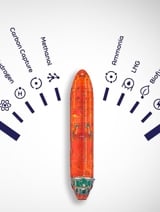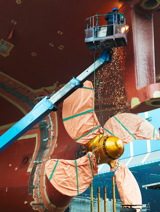Applicability: shipowners, ship managers, ship masters and designers.
New inspection, maintenance and procedural requirements for all ships
New inspection, maintenance and procedural requirements for all ships
Paragraph 9 of amended SOLAS Regulation II-1/3-8, as amended by resolution MSC.474(102), states that “for all ships, mooring equipment, including lines, shall be inspected and maintained in a suitable condition for their intended purposes”.
For more information, consult the following:
- LR Class News No. 14/2022 (which introduced the new requirements).
- IMO MSC.1/Circ.1620, “Guidelines for Inspection and Maintenance of Mooring Equipment including Lines” (on how to comply with the new requirements).
- IMO MSC.1/Circ.1362/Rev.2 (recently published, which includes several interpretations relevant to the new requirements).
What should shipowners and ship managers do now?
Owners (or ship managers) should establish the following onboard maintenance and inspection procedures:
- Procedures for mooring operations, inspection and maintenance of mooring equipment, including mooring lines.
- Procedures to allow the identification and control of mooring lines, tails and associated attachments.
- Periodic inspection of mooring lines, mooring line tails and associated attachments as part of the onboard maintenance plan or equivalent maintenance management system.
- Manufacturersʹ criteria for replacement of mooring lines should be available.
- Records of the original design concept, equipment, arrangements and specifications should be available on board.
Review your procedures
While normally most of the above are already covered by the onboard Safety Management System, it is highly recommended that companies review their procedures, records and forms to ensure the above items have been properly addressed.
For new construction, designers and shipbuilders should ensure the supplied documentation provides sufficient information (e.g. technical data, maintenance manuals, mooring rope specification and certificates) to support owners in developing their maintenance and inspection procedures.
Challenges for ships built before 1 January 2007
Ships with a keel lay date before 1 January 2007 were not required to comply with SOLAS, Chapter II-1/ 3-8, so may not have the original design concept to support the development of the new SOLAS maintenance and inspection requirements. For such cases, the following options are available:
- The original design concept could be a mooring arrangement plan or any document that specifies mooring specifications at the time of the ship’s construction.
- Alternatively, owners may establish the original design concept, including MBLSD (Ship Design Minimum Breaking Load) for mooring based on the safe working load of mooring equipment provided on board.
- If the vessel neither has any mooring documentation nor any safe working load marking on fittings, owners are advised to check the strength of mooring equipment and their supporting hull structure based on MSC.1/Circ.1175/Rev.1 (or rules applied at the time of construction, such as IACS Recommendation 10). Owners should also determine MBLSD based on actual capacity of the equipment and their supporting hull structure on board. In this case, calculations should be submitted to Lloyd’s Register (LR) for appraisal.
On a consultancy basis, LR may also support owners carrying out calculations to determine the MBLSD for establishing the original design concept, based on the owner’s available information. These calculations are carried out independently of any subsequent plan appraisal.
When will surveyors verify the requirements?
The maintenance and inspection procedures above are required to be confirmed on board at the time of:
- Initial surveys completed on or after 1 January 2024 for new ships;
- First Cargo Ship Safety Construction survey (annual, intermediate or renewal), on or after 1 January 2024, for existing ships; or
- Passenger Ship Safety survey, on or after 1 January 2024, for existing ships.
For further information
For further information or advice, please get in touch with your local Lloyd's Register office or contact statutorysupport@lr.org






